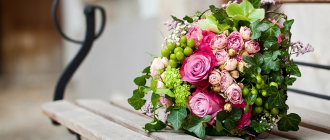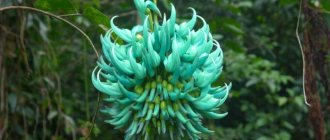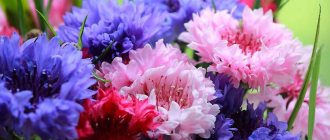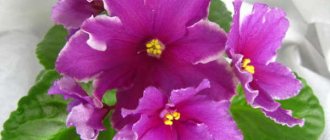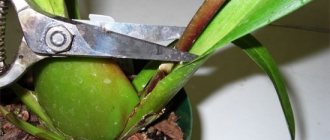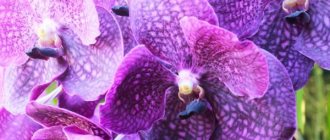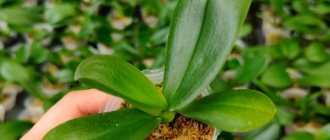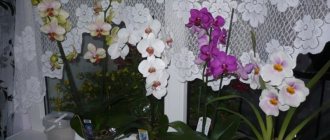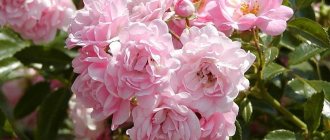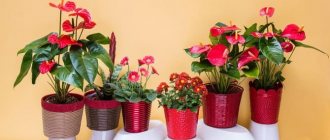Ampelous fuchsia with its long stems hanging from a hanging flowerpot gained popularity not so long ago and immediately won the hearts of all flower lovers who appreciated its decorative charms and characteristic properties. Several flowerpots with an ampelous variety of this plant can skillfully decorate a porch, balcony, terrace, veranda or a fairly large wall of a house.
Description
Fuchsia is a perennial plant of the Fireweed family. Thanks to the numerous variety of ornamental varieties with unusual bright colors, this tenacious evergreen flower has deservedly taken its place of honor among ornamental plants. Many hybrid forms of fuchsia are known: with straight stems, with pyramidal ones, spreading, hanging, climbing, in the form of a bush or tree. Of particular interest in modern design is ampelous fuchsia with thin stems forming a crown in the form of a cascade. The length of the bright green oval-shaped leaves with sharp tips is about 5 cm.
The variety of flower colors is amazing in its diversity: white, red, pink, blue, light blue, purple, yellow. The flowers themselves have an unusual shape due to the protruding stamens from under a lush petal skirt that emerges from a tubular corolla.
In the modern world, fuchsia was previously known only as a houseplant that blooms all year round. But over time, it increasingly began to appear on the street in the warm season, decorating the exterior of houses and flower beds of gardens. About ten thousand varieties of this plant are known in the world.
With proper care, it can bloom from spring to autumn, its peak flowering is in April and October. The plant is so unpretentious that gardeners find caring for it a pleasure.
Varieties for growing in pots
Fuchsia is native to South America and New Zealand. It was from there that many varieties of this plant were brought. Ampelous fuchsia was recently bred. There are known double, semi-double and simple varieties, some of which we will briefly consider.
- «Holly's Beauty" is a flower variety in white and pink tones, with double petals.
- «Prince of Peace" is a plant that blooms ordinary flowers with white sepals and a red skirt.
- «Blue Angel" is a plant variety famous for its chic combination of lilac and purple shades of flowering, edged with white sepals.
- «Imperial Crown"- a plant with elongated scarlet flowers collected in clusters.
- «Bicentennial"- an ampelous variety with oblong, rather large double flowers in the form of buds with sepals in light colors, which over time transform into orange.
- “ Marinka ” is an ampelous fuchsia, the flowers of which are ordinary and monochromatic, but look wonderful due to their extraordinary brightness and abundance.
- «Santa Clara" - a variety with large double flowers, consisting of a cherry-colored “skirt” and white sepals.
- «Niedersachsen"- a very spectacular fuchsia with large double flowers, whose sepals are red with a white edge. The popular name for this fuchsia is “ballerina”.
- «Peachy» - ampelous fuchsia with large oblong buds. The flowers of this plant are double with white sepals with a delicate pink edge.
The following types and varieties of fuchsia can also be placed in flowerpots:
- «Annabel"- a variety in ampelous form, but can also be grown in the form of a bush; it has fairly large, white double flowers with a slight pink tint.
- Fuchsia trifoliata - bush up to 60 cm, growing horizontally. This variety is convenient to grow in pots. It has ovoid green leaves about 8 cm long, the front side of which is tinged with red and the bottom is brown. There is a small fluff on the leaves. Three-leaved fuchsia flowers in the form of a bell of red color with an orange tint are collected in several flowers in an inflorescence. Great for decorative use to create entire flower arrangements.
- Fuchsia recumbent - a creeping plant with upward-pointing flowers in pink or orange tones. Suitable for pots and flower arrangements. It blooms in the warm season with single flowers.
- Fuchsia bright red - a luxurious plant with scarlet flowers on thin stems. The oval-shaped leaves are placed on small petioles.
- «Archie Owen» is a semi-ampelous variety with impressively sized flowers in pink tones.
- «Bella Rosella"is one of the few fuchsias with the largest double flowers in lilac and pink colors.
- «Blue Mirage" is a plant that can be either in a hanging form or in the form of a bush. It has amazing deep purple flowers with white sepals.
- «Blue Veil"- a plant with beautiful lilac petals, bordered by white sepals with green tips. It can grow in a hanging form and as a bush.
- «Cecile“is an unusually beautiful ampelous bush plant with wavy lavender petals of dense flowers and pink sepals.
In flowerpots, all ampelous varieties of this plant look simply unsurpassed; they can transform even the most modest exterior of a house.
Primrose varieties Ballerina
The Belarina series has a wide variety of varieties. Today there are more than 50 of them. Each of them is unique and has its own care recommendations. Not everyone is able to withstand low temperatures and heavy rains, so in order to grow a flower on your own site, you need to know the characteristics of each variety.
Did you know? Due to the fact that primrose inflorescences look like a bunch of keys, the flowers are popularly called “keys”.
Cobalt Blue
The Cobalt Blue variety has a height of 10–15 cm . Double flowers are bright blue, with a diameter of 4 cm. The flowering period occurs at the end of spring - beginning of summer (May - June). The leaves are oval, oblong, with serrated edges. Their length is up to 20 cm, and their width is up to 4 cm. The plant prefers partial shade and fertile soil. Cobalt Blue does not tolerate stagnant moisture or close proximity to groundwater.
Pink Champagne
The Pink Champagne variety has a delicate pink hue and a pleasant aroma . The flowers look beautiful among other plants that can create the partial shade necessary for primrose. The planting site should be in a slightly shaded area. The plant has a height of up to 15 cm. The flowers are collected in rosettes, double and lush, and begin to bloom in April. The flowering season ends in June.
Pink Ice
The Pink Ice variety can surprise with its color: white with a lilac-pink tint. The flowers have a pleasant, persistent scent and bloom from May to June. Primrose variety Pink Ice is in zone 4 of frost resistance.
Butter Yellow
Butter Yellow features dense, rich green, toothed leaves. They are covered with a white coating and can reach 20 cm in length. Flowers 10–25 cm high have a red tint. The flowering period begins in April and lasts for 40 days. The plant prefers slightly acidic and neutral soils.
Valentine
The Valentine variety has a rich wine hue. Double flowers are dense and lush. They are collected in sockets of 5–20 pieces. The leaves are oblong, lanceolate. The plant reacts negatively to hot sunlight.
Nectarine
Primula vulgaris Belarina Nectarine has large double flowers. They are characterized by a yellow color with an orange-pink edge. The Nectarine variety loves porous, light soil. The plant blooms already in April and begins to bloom again in the fall.
Conditions for fuchsia
If you create comfortable growing conditions for ampelous fuchsia and provide it with proper care at home, then it can delight others for many years.
Lighting and temperature
Ampel varieties of fuchsia feel comfortable in partial shade or in light with moderate brightness, do not like direct sunlight, and do not tolerate drafts and cool air. Direct sunlight has a depressing effect on them: the plant will not die, but the flowers will become very small, the leaves will thin out significantly, and it will be almost impossible to return to its former luxurious appearance. All these factors must be taken into account when placing them.
Fuchsia feels much better in a place where it receives sunbathing only in the morning, and from midday until sunset it is advisable for it to be in partial shade. The eastern side, as well as the southwestern side, suits her best. But it should be noted that with a long stay of this flower in a shady place, the number of flowers noticeably decreases.
If there is not enough light for a long time, the plant will not bloom or may die. In this case, it must be moved to a brighter place; if this is not possible, then artificial lighting can help out.
The optimal temperature for growing fuchsia should be approximately +22 °C during the day and not lower than +15 at night. Very high and low temperatures negatively affect the flowering process. The plant adapts to temperature conditions: when there is a lot of light and heat around, flowering cannot be stopped (spring, summer, autumn), but if it gets colder, buds no longer appear, flower development slows down (at the end of the autumn period, in winter).
Container size and substrate
All parts of fuchsia do not like high temperatures, including its rather delicate roots.
In an ordinary pot, the roots can easily overheat. If the plant will overwinter on a windowsill indoors, then thermal insulation must be made under the container.
Fuchsia is not very demanding on the soil for growing, but it feels more comfortable in fertile, neutrally acidic soil with easy air access, and for this the soil must be porous. There are several options for combining the components of an earthen mixture intended for growing this flower; it is also acceptable to use a ready-made mixture for any plant. The substrate for fuchsia can consist of peat, humus, turf and leaf soil, sand, and expanded clay can be used for drainage. The earthen mixture is also made from peat, sand, perlite and clay.
Planting and propagation
The processes of planting ampelous fuchsia, propagating and caring for it have a number of features that must be adhered to. Propagation of this plant is best done in early spring using cuttings or planting seeds. The first method is much simpler.
Seed method
At home, fuchsia is grown by seed extremely rarely, except for the purpose of experimenting. This process is quite complex and has many nuances, but it cannot be said that it is ineffective.
Seeds can be purchased at a specialty store. They can also be collected from a house plant, which is a very entertaining process. First, you need to avoid self-pollination; for this purpose, you need to tear off the anthers on the flower and place pollen of the desired variety on the stamens.
After this, wrap the bud in gauze and secure it with a thread; it will remain in this state for less than a month, until the fruit appears. All this time, any movement of the flower is contraindicated. The finished fruit is removed, carefully cut and the seeds are removed, which need to be dried.
Only after this are the seeds ready for sowing, which is best done in early spring. Fuchsia seeds are placed on the surface in wooden boxes with a mixture of peat and coarse sand and pressed lightly with your fingers. It is not recommended to plant seeds deep into the soil: they may not sprout.
The boxes are covered in the form of a small greenhouse with sufficient lighting without direct sunlight, creating the necessary humidity and temperature within 18–22 ° C. Regularly, once a day, the greenhouse must be opened for ventilation for several minutes, and the condensation that has formed must be removed and watered with settled water at room temperature using a sprayer. If you approach this process responsibly, sprouts will appear in a maximum of two weeks.
After sprouting, the greenhouse can be left open for a longer time each time so that the sprouts quickly get used to normal humidity and room temperature. After the young plants have grown noticeably and become accustomed to natural conditions, they are transplanted one by one into separate pots, before which the plants and fertile fertilized soil are well moistened. Pots with planted young flowers are placed in a shaded place for the first time. Further care for such plants consists of fertilizing every two weeks after planting, regularly fertilizing the soil, placing the plant in high-quality diffused lighting, systematic watering, pruning during the period of active growth, and annual replanting.
Vegetative propagation
The optimal way to propagate fuchsia is using cuttings, which can easily avoid problems: the shoots take root well. This method is more popular and much simpler than the seed method. Its main advantage is a small waste of time with excellent results. The best period for this breeding is also spring. Young shoots are ideal for cuttings, because old woody shoots take much longer to take and grow more slowly.
The length of each cutting is individual and depends largely on the variety of fuchsia; it can range from 8 to 20 cm. Before placing the shoot in settled or filtered water, you need to tear off the leaves so that none of them come into contact with the water, otherwise they will begin to rot and mold , and this will have a detrimental effect on the condition of the cutting.
Large leaves on the shoot are also not needed: they take away a lot of the moisture it needs to form a root. The glass with the shoot must be covered with polyethylene to maintain a sufficiently high humidity. If everything is done correctly, the roots on the shoot will be noticeable within a few days, but another couple of weeks are needed for the root to become full-fledged.
You can replant a young plant into the soil when the first roots appear; it is not necessary to wait for the entire root system to form, but it is still safer to wait these couple of weeks.
Further care for young flowers follows the same rules as for plants obtained from seeds. There is another way of propagation using cuttings - when they are planted directly into the substrate, but at the same time you need to make a kind of greenhouse over them, the exit from which is a little troublesome for gardeners and dangerous for the sprouted plant itself: it may even die if something is done wrong or hasty.
How to propagate fuchsia is up to each individual to decide; the main thing is to learn all the simple rules, and it will definitely take root and bloom.
Features of care
Ampelous fuchsia deservedly enjoys the love of gardeners not only for its attractive appearance, but also due to its unpretentious care in the garden, in a flower pot, in a flower bed or in a pot on the windowsill. After all, the cultivation of ampelous fuchsia can take place both in the shade in the garden and in an open space not protected from the sun; it does not make any special demands on the nutritional value of the soil and frequent watering, and you can get as much pleasure from its beauty as no other plant.
Watering and spraying
Rational watering is of great importance when growing fuchsia. How often to water this plant and how much liquid it needs is influenced by various factors: weather conditions, the type of flower, its location, stage of development, and even the size of the pot and the material from which it is made.
For irrigation, it is recommended to use settled or melt water. It is necessary to water the flower in fairly moderate quantities. During active development, the soil should be slightly moist. In the summer, spraying with fairly cool water will not hurt the ampelous fuchsia.
It is better to drain the excess water remaining after watering. From late autumn, it is enough to water the plant no more than once every two weeks. With the arrival of frost, you can practically not water the plant or do it very rarely.
Trimming
Pruning fuchsia is a must. It promotes plant rejuvenation and crown formation, and prevents the process of bare stems. Pruning is carried out annually in the spring. The shoots are cut to a third of their length along the entire circumference of the flower in order to create symmetry of the plant.
Fertilizer
Fertilizing fuchsia is necessary for its better development. A fertilized plant is noticeable from a distance: it blooms unusually beautifully and develops luxuriantly. They usually begin to fertilize these plants as soon as the first flowers appear, and continue to do this while it is actively blooming and developing. Fertilizing is done approximately once a week with liquid complex fertilizers for plants, in which it is necessary to control the nitrogen level. In winter, the flower does not need fertilizer.
Transfer
The replanting process is also very necessary for fuchsia to form, because with the new soil it receives all the necessary microelements and nutrients. Young plants are replanted once a year; older plants need to be replanted once every three years.
The transfer method is optimal for replanting fuchsia: it is carefully transferred, preserving the integrity of the old soil with the root system, and a fresh earth mixture is added to the free space of the pot, preventing the formation of a void between the root system of the flower and the walls of the pot. After this, the plant must be watered and left to adapt. In no case should you forget about the drainage layer.
agronomu.com
Further care for Ballerina roses
The Ballerina rose variety does not require special care; even beginners can cope with its cultivation.
Watering and humidity
This rose should be watered rarely and moderately - Ballerina does not like the soil to be heavily moistened
, calmly tolerates long periods of drought. Also, this perennial shrub is resistant to rain, which does not cause much harm to either the blooming buds or foliage.
Roses of unusual colors
Feeding bushes
During the period of growing green mass, rotted manure is placed in the root zone of the bushes. And during flowering, mineral fertilizers are applied to the Ballerina at intervals of two weeks. Such fertilizing should be carried out in liquid form, diluting the preparations in the following proportion: for each bucket - 1 tbsp. l. substances.
General description and types of plants
Fuchsia is extremely common in its homeland. It has more than 100 species, differing in color, size and shape of flowers, flowering times, leaves, etc. All types of fuchsia growing in nature can be divided into 2 large groups :
- tree-like;
- bushy.
The most common varieties of fuchsia found in nature are:
- Fuchsia brilliant;
- Fuchsia Magellanica;
- Fuchsia corymbosa;
- Fuchsia Boliviana , etc.
For home cultivation, it is necessary to select varieties of Fuchsia hybrida . Outwardly, it looks like a small bush, all strewn with unusual flowers, which in shape are associated with a ballet tutu, i.e. just as lush and wavy.
The color range of these flowers is quite wide: from white to purple, from blue to violet. Caring for such a plant, knowing and following its basic rules, will not be difficult even for novice gardeners.
What favorable conditions need to be created for fuchsia so that it will delight you with its lush growth and abundant flowering on the windowsill at home? This should be looked at in more detail.
Caring for indoor Ficus Benjamin plants can be very simple.
One day you will need to know how to fertilize phalaenopsis orchids, about this in our article.And geranium can be propagated not only by cuttings, but also by seeds https://sad-doma.net/houseplants/dekarativnotsvetushhie/geran/geran-razmnojenie.html
Basic rules for caring for fuchsia during the growing season
The main measures for caring for fuchsia, after its acquisition, are considered:
- correct choice of location;
- compliance with temperature and humidity conditions;
- feeding
In the life of fuchsia, two periods :
- active growth: from spring to autumn;
- relative rest: winter.
Let's consider the rules for caring for a fuchsia flower during the period of active growth . At this time, the plant should be placed on a well-lit windowsill of an eastern or western window, but not in direct sunlight. It is better not to put fuchsia on southern windows, because... she is too likely to get sunburned.
If there is no bright place in the house for fuchsia, then it should be provided with additional
artificial lighting , using, for example, fluorescent lamps.
Otherwise, fuchsia blooms may not be seen. This also applies when installing a flower on a northern windowsill with insufficient light.
The plant loves clean, often ventilated air . The presence of drafts is unacceptable. Rearrangements from place to place and rotations around its axis are not desirable for fuchsia. The air temperature during this period should be approximately +20+22 degrees.
higher ambient temperatures You can place fuchsia on a balcony, loggia, or open terrace in the summer. To prevent the sensitive root system of the plant from overheating in the heat, you need to transplant it into a wide ceramic pot.
Watering fuchsia during the growing season should be moderate: the soil should not become moldy or dry out. Water for irrigation should be used that is settled, soft, and at room temperature. In the hot season, the plant needs to create an additional humid microclimate.
Early in the morning or in the evening it is good to spray fuchsia with cool water. You can place a beautiful container with water and pebbles next to the flower, which will help create the desired microclimate around the flower.
The plant needs weekly feeding with fertilizers throughout the active period. After flowering has stopped, you can take a short break from using fertilizers. In the fall, from about September-October, fertilizing the flower is gradually stopped. As fertilizers, special fertilizers for house flowers are used with a high content of phosphorus and potassium, which are so necessary for the normal functioning of the flower.
With proper care, fuchsia will delight everyone with its long and lush flowering, from May to the end of November. A prerequisite for long-term flowering of a plant is the constant removal of faded flowers .
Throughout the growing season, the plant should be constantly pinched to form the desired shape. You need to be prepared for the fact that each pinching delays flowering for almost 2 months.
At home, fuchsia should be replanted annually . It is better to carry it out in March. The scheme for this is simple: first, drainage is placed in the pot, on which the prepared earthen mixture is placed, the plant with the earthen lump is carefully transferred and sprinkled with earth.
Growing from seeds
Primrose is a unique ornamental plant that can be used:
- in open ground in combination with bulbous flowers, such as daffodils and tulips;
- in composition with foliage plants;
- as a “living carpet” of flowers;
- for growing in pots and flowerpots indoors;
- for planting in containers that decorate terraces.
Did you know? Primrose has many beneficial properties. It is used to prepare spring salads, and seasonings for dishes are made from the root.
To grow a plant from seeds, you need to take a responsible approach to the choice of soil and container for planting. Slightly acidic or neutral soil is best. It should sift well, be light and porous, so that the roots of young plants have the opportunity to receive enough air and moisture. To improve water permeability, sand and coconut fiber can be added to the soil.
Special containers for sowing primrose seeds can be purchased at a flower shop. At home, they can be replaced with cut-off plastic bottles and various confectionery packaging. It is important to create a greenhouse effect for the seeds, so you need to provide a film at home. Soil temperature plays an important role for seeds. It should be about +5...+10°С and during stratification should not fall below –10°С.
Step-by-step instructions for growing primrose from seeds using the stratification method:
- Pour 3–5 cm of soil into the container, make the next 2 cm layer of snow.
- Sow the seeds on the snow so that the distance between them is about 0.5 cm. This is necessary in order to make it more convenient to plant the seedlings in the future.
- Store the container for stratification for 10–14 days in a cool place. This could be a snowdrift, a basement or a refrigerator. In 2 weeks the first shoots appear.
Video: Stratification of primrose seeds
Stratification is necessary for plants to adapt well to cold, but it is not mandatory. The container can be left indoors on the window. In this case, the seedlings will begin to hatch within 5–6 days from the moment of planting.
Planting primrose in open ground
Primrose is planted in open ground in autumn or spring . Seedlings must be two years old. Planting is carried out in loose, moist soil. The distance between plants during planting in open ground should be at least 20 cm. Primrose grown from seeds begins to delight with its color only after 2-3 years.
Important! The site for planting a perennial plant should be in partial shade, since primroses do not tolerate aggressive sunlight.
Plant care
Caring for primroses is simple and does not cause difficulties even for beginners. It consists primarily of watering. You need to moisten the soil once a week, after which you should carry out weeding and loosening. During periods of drought, flowers should be watered with 3 liters of water per 1 m².
Perennial plants need regular feeding. The first fertilization procedure is carried out after the leaves appear, the second after the flower stops blooming. When feeding, you need to take into account that excess nitrogen in the soil can cause the primrose to not bloom the next year. Phosphorus and potassium fertilizers are considered suitable fertilizers. For the best effect, they need to be alternated.
Basic rules for caring for fuchsia during the dormant period
In winter , when caring for fuchsia, you need to take into account that the flower is in a state of sleep and dormancy.
During this period, it is important to create optimal conditions of detention. temperature during this period should not rise above 10 degrees. For this purpose, when growing a plant in a city, you can use an insulated loggia.
Good lighting and a constant flow of fresh air must be provided in sufficient quantities during the winter period. In exceptional cases, fuchsia can be left for a period of rest without light. Watering the plant in winter is significantly reduced - up to 1-2 times a month. But the soil is not allowed to dry out. During the dormant period, fuchsia should not be fertilized. It is important to know that if the specified plant care is not followed in winter, fuchsia will not bloom during the growing season.
Reproduction
Primrose can be propagated in several ways:
- Dividing the bush.
- By cuttings.
- Seeds.
Important! Planting and dividing plants can be carried out once every 4-5 years.
To replant, you need to dig up the bush with its roots and remove the soil lump. The root system is washed with water and then cut with a sharp knife. The wounds at the site of the cuts should be sprinkled with ash and immediately planted in a new area.
To propagate primrose by cuttings, you need to separate the leaf from the bush along with the bud and part of the stem. The resulting planting material should be planted in the soil, having first shortened the leaf by ½ part.
Primrose from the Ballerina series is a bright way to decorate your garden or home. Caring for the plant is simple, which allows even amateur gardeners to grow a perennial, velvety, lush flower.
Propagation of fuchsia at home
With proper care of the fuchsia flower, propagated using:
- leaves;
- seeds;
- Cherenkov.
With the help of leaves, flower propagation occurs as follows: good material is selected - stems with highly developed leaves, which is sprinkled into prepared loose soil to a depth of 1-2 (cm). The leaves are moistened with warm water using a spray bottle and covered with transparent material.
Spraying the plant should occur daily. The young plant is transplanted into a pot when small rosettes appear on its stem. It is impossible to do without artificial pollination when propagating fuchsia by seeds at home.
Experienced flower growers, when cross-pollinating plants, mix several different varieties. As a result, new plant hybrids with a variety of colors of flowers and leaves are obtained.
But the cutting method of flower propagation is considered the most common. The best time for this is spring or autumn. To do this, plant cuttings 6-7 (cm) long are taken, which are placed in water or rooted in loose prepared soil consisting of humus, sand, and turf soil.
Throughout this period, the cuttings are sprayed with warm water. After about 3-4 weeks, when the young plant has formed roots, it is transplanted into a prepared pot. When you get a lush plant, you need to transplant several of these cuttings into one pot. To the delight of many gardeners, the young plant will bloom in the same year.
Thus, fuchsia, with proper care, will create a unique atmosphere of comfort, joy and light in the house.
And for the most curious, we suggest you watch a video trailer about the variety of types of fuchsia.
sad-doma.net
Types and varieties of fuchsia
Fuchsias can be grown as ampelous, bush plants, or formed into a pyramidal or standard tree.
Varieties can bloom in different seasons of the year. As a rule, almost all varieties have edible fruits (berries), but in room conditions they are difficult to ripen; you must wait until they turn black before using them for food.
Bush
| View | Description | Leaves | Flowers, their blooming period |
| Three-leaved | Size 60 cm. It grows in breadth, so it is good to place it in a hanging container. Large berries (5 cm). | Ovoid. 8 cm long and red in color, the back is greener and the underside is brown. | A large number of bell-shaped species, connected by fiery sepals into inflorescences. May - October. |
| Waist | Height - 50 cm. The fruits have a delicate taste. | Velvety dark green with hints of burgundy. | Bright orange medium. Spring - autumn. It can be extended throughout the winter by providing (temperature +25 °C) and lighting for at least 12 hours. |
| Magellan | Reaches 3 m. Sweet, tart. | Small, pointed (up to 4 cm). | Tubular from red to white colors. Spring - autumn. |
| Sparkling | Size 2 m. The fruits are edible. | Large serrated. | Scarlet. Summer. |
| Shiny (shining) | Height from 40 cm to 1 m. The berry is edible, rich in vitamins. | Large oval, green with a purple tint. | Raspberry-purple. April - November. |
| Graceful | Up to 1 m. Similar to Magellan. | Elongated oval (up to 5 cm). | Voluminous, bright pink, maybe with a purple center, sitting on small stalks. Spring - late autumn. |
| Splendence | Multileaf. The fruits are larger than other species (5 cm) with a tart lemon flavor. | Simple oval-lanceolate. | It looks like a long red pipe with light green petals at the ends. Whole year. |
| Bolivian | Beautiful, spectacular. Grows up to 1 m. The berries have a slight narcotic effect. Light lemon and pepper flavor. | Large velvety. | Collected in brushes, red and white, large. March, April. |
| Bright red | Reaches 1-1.2 m. The fruits are difficult to grow at home. | Lanceolate (3-5 cm). | The tubular sepals are red, the petals are purple. Beginning of April - end of October. |
| Thin | Grows up to 3 m. Narrow flowing reddish branches. Can be trimmed to guide its growth in width. | With a burgundy tint. | Numerous violet-purple. Collected in brushes. July - September. |
| Thyroid | Height - 3 m. The fruit is rich in vitamins. | Oblong-oval up to 7 cm. | White, red with a purple core. Mid-summer - early autumn. |
| Recumbent | 40 cm-1 m. Thin creeping shoots. The difference is diversity. Light red berry. | Round or heart-shaped. | Yellow, growing upward. April - November. |
Other beautiful varieties with double and semi-double flowers:
- Alisson Bell (violet-red);
- Anabelle (white);
- Ballerina (scarlet in the middle of a light pink skirt);
- Henriette Ernst (sepals - deep pink, petals - soft lilac).
Ampelous types:
- Blue angel (terry, white with lilac);
- Hollies Beauty (purple-blue);
- Imperial Crown (scarlet);
- Prince of Peace (white with red center).
DESCRIPTION AND GENERAL INFORMATION ABOUT FUCHSIA
The fuchsia genus includes more than 100 species. In home floriculture, fuchsia has become especially popular after the development of hybrids that are easily propagated by seeds and begin to bloom in the first year of life.
The oval leaves of fuchsia are slightly pointed at the edges and are usually attached to the stem opposite each other. The color of the leaves is green or slightly reddish. The graceful shape of the flower is created by the combination of a bright calyx, a tubular corolla (it can also be bell-shaped or funnel-shaped) and stamens and pistil peeking out from below. The main color of the buds: pink, red, lilac, white, cream, violet, etc. Sometimes fuchsia petals can be colored in two or three colors at the same time.
A LITTLE HISTORY
Fuchsia was discovered at the end of the 17th century by the French priest Charles Plumiere. He went on a trip to South America in search of medicinal quinine. In the eastern part of the island of Haiti, a traveler found an unusual flower and named it after the famous physician and botanist Leonard Fuchs of that time. The full name was Fuchsia Triphylla Flora Coccinea. Subsequently, systematizer Carl Linnaeus simplified the name to the species F. Triphylla. Unfortunately, Plumiere was unable to bring a single plant to Europe. The generally accepted date for the discovery of fuchsia is 1703, when the researcher's notebook was published.
The flower was first brought to England in 1789. The plant was donated to the famous Kew Botanic Gardens. Much later, when F.magellanica came to Europe, new varieties and hybrids of fuchsia were developed. And at the end of the 18th - beginning of the 19th centuries, fuchsia began its victorious march across Europe. The exotic flower began to be grown both as a home and garden plant. Fuchsia is still of interest to gardeners, and in America there is even an American Fuchsia Society (AFS), whose goal is to streamline and systematize the diversity of fuchsia hybrids and varieties.
TYPES AND VARIETIES
The fuchsia genus has more than 100 species and more than 10,000 varieties. Below are just a few of them.
Bolivian (boliviensis) fuchsia
- Bolivian (boliviensis) fuchsia. The habitat of this species is Bolivia, Ecuador and Argentina. It is a small shrub about a meter tall. Small oval LEAVES (10-15 cm) have jagged edges. Large buds (6-8 cm) are dark red;
Magellan fuchsia
- The homeland of Magellan fuchsia (also graceful (gracilis) and thin (macrostemma)) is Chile. It was this species that was first brought to Europe. The plant in natural conditions reaches a height of 1 to 3 meters. The leaves are small (1-2 cm), finely toothed along the edges. The branches often have a reddish tint. Flowers of unusual purple and violet color. Drooping buds;
- brilliant or sparkling (fulgens) fuchsia grows in the Mexico region. A small shrub 1-2 m high. The oval, heart-shaped leaves are located opposite each other. The flowers are tubular, red-pink or bright red, collected in a raceme;
- The island of Haiti is considered the birthplace of triphylla fuchsia. The small shrub reaches only 50-60 cm in height. The leaves are small, oblong (1-3 cm) and have jagged edges. The underside of the leaf is colored reddish. The buds are bright coral color.
Popular varieties:
Fuchsia Dark Eyes
- Basseveldse Ezels - double white-pink-burgundy flowers;
- Bicentennial - a variety with magnificent long salmon-colored flowers;
- Dark Eyes - flowers have blue-violet sepals, dark red tubes, erect plant;
- Garden News - pale pink dainty flowers.
Fuchsia Garden News
Here are other interesting varieties: Litte Bell, Deep Purple, Quasar, Cecile, Baby Blue Eyes, Swingtime, Ballerinas, Wonderful, Blue Mirage, Margharita, Annabel and others.
Rarely shaped flowers: description and what they look like in the photo
Ballerina
The endemic Caladenia melanema grows in its natural environment in one place - in the South-West of the Australian continent near Lake Altam. Unlike most varieties of the plant, "Ballerina" grows in sand near salty lake water, and not on trees. By 2006, there were only three hundred mature plants from two populations.
The main feature of the flower is its shape, which in appearance resembles a dancing ballerina on pointe shoes with her arms gracefully raised up.
Other distinctive features of the species include the following:
- flower diameter – 4–5 cm;
- stem height – up to 15 cm;
- the shade of the inflorescence (in rare cases there are two, not one) is pale yellow or cream with reddish tints along the edges;
- has a single pubescent leaf.
Dracula or monkey face
Dracula simia is one of the rarest varieties of orchids native to the tropical rainforests of Central and South America. Most often it is found in Ecuador and Peru at an altitude of about two thousand meters above sea level.
The main distinguishing feature of the plant is the unique arrangement of the petals, folded into a pattern reminiscent of the face of a pensive or sad monkey. The flower also has a rich bouquet of aromas: from bright citrus, similar to the smell of ripe oranges, to unpleasant, reminiscent of rotten meat.
About 20 of its varieties are listed in the Red Book.
Other features of the plant include:
- grows only in low temperature conditions;
- blooms all year round, but in some varieties it lasts only a few hours, with the flowers opening sequentially;
- variety of colors - from snow-white to dark brown;
- the presence of several flowers on an inflorescence.
Carrot or catasetum and care for it
This type of orchid has the Latin name Catasetum and belongs to the group Catasetinae, which are affectionately called “carrots”. In total there are about 150 species. These unusual flowers grow in most regions of Central and South America, especially many varieties can be found in Brazil.
The catasetum orchid has intricately shaped flowers. Due to the pseudobulbs and long, hard leaves, the plant looks very beautiful even when there are no buds on it.
This orchid is characterized by pronounced sexual dimorphism, in which male flowers reach 10–12 cm in diameter, while female flowers do not look so large and beautiful.
Caring for carrots depends on the growth period. During the growing season, usually in early spring, when new pseudobulbs appear on the orchid, the plant is actively watered and fertilized. In this case, after 3-4 months the flower appears new peduncles. Towards the end of autumn, during the dormant period, the foliage begins to fade and turn yellow. Watering is reduced by half, and fertilizing is stopped. It is also necessary to reduce the temperature. In winter, watering the catasetum may not be done at all.
Ghost
Ghost Orchid or Dendrophylax lindenii was considered an extinct species until recently. The plant grows in shaded forests in Cuba, the Bahamas, and some US states, such as Florida. The flower has also been spotted eleven times in wetlands in Britain.
Grows in treetops and has no leaves but bright white flowers that resemble ghosts or frog legs. The height is small - only 15 cm.
The root system of the plant has a photosynthetic effect. The roots merge with the flower-bearing arrows, so it seems that the flowers appear in the air, as if from emptiness.
Sleeping baby
The Swaddled Baby or Sleeping Baby orchid is also called Anguloa Uniflora. This is a terrestrial plant from South America that grows in Colombia, Bolivia, Ecuador, Venezuela and Peru at an altitude of one and a half to two and a half thousand meters above sea level. The main habitat is shaded and cool areas of humid mountain forests.
A distinctive feature of the plant is the unique shape of the flower, which at the time of autumn flowering resembles a sleeping baby wrapped in an envelope with a pacifier in its mouth. The color of the flowers is light with a pinkish tint in the central part, the aroma is pleasant.
flying duck
Caleana major is a small plant (up to half a meter), leading a terrestrial lifestyle and growing in the south-eastern part of Australia. Outwardly, it would be difficult to distinguish it from ordinary grass, if not for the bizarrely shaped flower in the shape of a flying duck with a noticeable long beak.
The plant survives only in wild conditions; in closed ground it quickly weakens and dies.
Other features of the orchid include:
- number of flowers on a stem – from 2 to 4;
- has a single narrow-lanceolate leaf located near the base of the stem;
- color - purple, brown or red-brown, in rare cases greenish with dark marks on the petals;
- The flowering period is from September to January.
Happy alien
Calceolaria Uniflora is a long-lived plant from the Calceolariaceae family, capable of living up to a hundred years. Lives in the mountainous areas of South America.
The shape of the flowers in the shape of a “hoof” or “purse” resembles a smiling alien with small eyes. The color is bright orange with reddish dots that attract insects, and a white nectar disk at the bottom. Other plant features:
- light aroma;
- height – up to 20 cm;
- flowers do not fade for several weeks after cutting;
- Blooms at home for up to six months.
Pigeon or peristeria high
Peristeria elata is a sympodial epiphyte.
The plant is native to Central America, Ecuador and Venezuela, and is also considered an endangered species and the national symbol of Panama. The middle part of the beautiful flower has a unique shape that resembles a dove sitting in a nest. Other characteristic features of the orchid:
- height – up to 1 m;
- number of flowers – from 4 to 12;
- color – marbled white with purple ornaments;
- the aroma is similar to the smell of beer;
- The flowering period is from July to October.
Dancing girls
Impatiens Bequaertii is a collectible herbaceous perennial from the impatiens family and is not an orchid.
But it has an unusual shape, which is why it is on the list of the rarest flowers.
Native to the tropical forests of East Africa. The flowers resemble in appearance dancing girls in skirts with outstretched arms. Other features of the plant include the following:
- compact dimensions: stems – up to 30 cm in height, flower diameter – 1–2 cm;
- white or light pink color of the petals.
white heron
Habenaria radiata belongs to the tuberous medium-sized geophytes. The plant is found in Japan, China, Korea, Russia, and is included in the Red Book of the Primorsky Territory.
The shape of the flowers resembles a snow-white heron flying high. Other characteristic features:
- height – up to half a meter;
- flower diameter – 3–6 cm;
- number of inflorescences – 3–4;
- number of leaves – up to 8 pcs.
Laughing bumblebee
Ophrys Bombyliflora is native to the Mediterranean. Grows in Turkey and Lebanon, Portugal and the Canary Islands.
The flowers are shaped like a smiling bumblebee with brown-red or purple-spotted colors. They imitate the scent of a female, inducing male bumblebees to pollinate them. The height of the plant does not exceed 20 cm, the number of flowers with green sepals formed between February and May is from 2 to 5 pieces.
Another name: hairy spider.
Naked man (Orchis Italianus)
Orchis italica is a rare perennial that grows in the Mediterranean, Sardinia, Portugal, Spain, Morocco and Lebanon. The Italian name of the plant is Naked man Orchid; it is in Italy that the flower is protected.
The flower received its special name because of the shape of the lamellum of each flower, which resembles a naked man in appearance. Other features of the plant include:
- height – up to 50 cm;
- petal color – bright pink;
- flowers – densely grouped;
- The aroma is pleasant, but quite strong.
Hot lips
Psychotria elata is a tropical, low-growing native of the forests of Central and South America from the Mirena family. Another name is “Hooper's Lips.”
Until the flower fully opens, its shape resembles bright red lips, ready for a kiss. Presumably, the plant, due to its unusual appearance, attracts pollinators - hummingbirds and butterflies.
Angel
The orchid Habenaria Grandifloriformis is distributed throughout the world with the exception of Antarctica. In total there are about 800 species of this plant, some of which can be found in the Far East of Russia, where they are called “Povodnik radiata”.
The shape of the flower resembles an angel with spread wings behind its back. The color of the petals is snow-white.
Read here what other orchids are white.
bearded
The low-growing plant Calochilus robertsonii grows on the Green Continent and New Zealand. This orchid can be found in dry forest areas.
The lamellum is covered with purple hairs mixed with brown, reminiscent of a long beard. The flowers are small (diameter does not exceed 2 cm), the number is from 2 to 10, the stem is fleshy, erect, the flowering period is from September to January.
Fly
Ophrys insectifera belongs to the genus Ophrys. It grows in alkaline soils in Europe.
The flowers are similar in shape and dark shade to a fly, but the main pollinators are wasps, hornets, bumblebees and bees. The smell of an orchid is quite pungent and imitates the pheromones of a female insect. Flowering - in June.
Platistel
Platystele ovatilabia was discovered quite recently. It was discovered by Professor Jost in the Cerro Candelaria nature reserve, located in the eastern part of the Andes in Ecuador.
Today the flower is considered the smallest in the world. The length of its absolutely transparent petals does not exceed 2 mm.
Lady's slipper
Cypripedium calceolus
This species includes several genera of orchids, which are united by a plant shape similar to a shoe or slipper.
Cypripedium calceolus (common slipper, real, "marin") belongs to the orchid family. The plant is distributed throughout the European and Asian continents, growing in the USA and Canada. The flowers are painted in a bright yellow shade. The configuration is cup-shaped, resembling a miniature shoe.
Paphiopedilum or paphiopedilum has won the attention of flower growers in many countries thanks to its hybrid varieties, which are unpretentious in care, unlike their natural counterparts. The most popular varieties for indoor growing are Gratrixianum and Bellatum.
Read more about the variety of Paphiopedilum varieties here.
Odontoglossum
Odontoglossum is a herbaceous perennial. Grows in open areas in the wet forest zone. Prefers hills.
The plant can be found in Central and Western South America and Guyana. The shape of the flower resembles a tongue with two tooth-like outgrowths at the base of the lip of the flower corolla. Color: from snow-white to bright yellow and green-brown.
You will learn which varieties of odontoglossum can be grown at home from this article.
